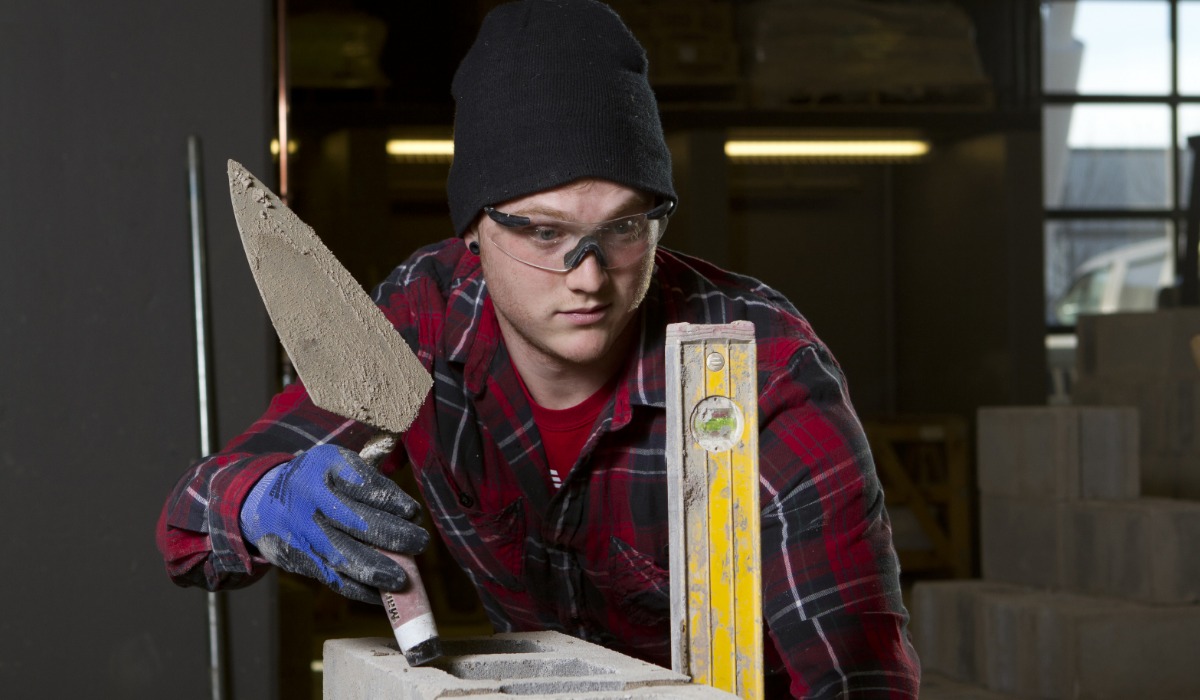Overview
Learn to prepare and lay brick and other masonry units to build and fix structures such as partitions, patios, arches, fireplaces and chimneys.
As a bricklayer apprentice, you’ll also learn about the materials and equipment needed to construct, repair and maintain structures and wall systems. This includes grouted walls, veneer walls, insulation and vapour barriers and refractory systems such as kilns, smokestacks, boilers and more.
You'll work with different mortars and materials like brick, concrete block, stone, mechanically fastened panels, firebrick, acid tile/brick, and other castable refractories. Becoming familiar with commercial, residential, and industrial masonry practices and techniques will make you a knowledgeable and well-rounded tradesperson.
As a bricklayer, you'll:
- read and understand drawings and blueprints
- estimate materials needed for a project
- measure from an established starting point and use a trowel and masons' level to build walls of various heights
- spread mortar over the base of a previous course of bricks and lay bricks into position
- remove extra mortar once a brick (or other masonry material) is in position
- use tools like a hammer, chisel, or masonry saw to cut masonry materials to fit as needed.
By the end of your training, you’ll know about different types of mortar and other materials used in bricklaying and how to work with them.
Bricklayers are skilled tradespeople with a knack for creativity, are highly motivated, and enjoy working collaboratively.
If you enjoy solving problems and possess a natural ability to bring a concept to life from beginning to end, you’ll do well in this line of work.
To succeed in this trade, you should:
- be interested in design and creative
- be comfortable working with various power and hand tools and materials weighing more than 25 kilograms
- have manual dexterity and a good sense of balance
- be a team player
- enjoy working with customers
- have an eye for detail, line and proportion
- be committed to maintaining health and safety in the workplace.
Upon successfully completing the required working hours and technical training periods, you'll be awarded a diploma in addition to journeyperson status by Alberta’s Apprenticeship and Industry Training.
This is a Red Seal Endorsed trade – a recognizable standard that allows tradespeople to work across Canada.
Careers and opportunities
Our graduates may work in the following occupations. Some careers require additional experience and education.
Associated National Occupational Classification (NOC) codes: 72014, 72320, 73100, 73101.
Apprenticeship training
The term of apprenticeship for a bricklayer is three years (three 12-month periods), including a minimum of 1600 hours of on-the-job training and eight weeks of classroom instruction at SAIT each year.
Year 1 | Period 1
You'll start by learning occupational skills, tools and equipment. You will then learn masonry materials, layout, procedures and masonry assembly.
Training length: 8 weeks
Year 2 | Period 2
You'll then learn occupational skills, wall system design, concrete block construction, above-grade masonry and masonry assemblies.
Training length: 8 weeks
Year 3 | Period 3
You'll then learn occupational skills, masonry assemblies, restoration and repair, chimneys and fireplaces.
Training length: 8 weeks
Apprenticeship education performance
You must pass each section of the course and the AIT exam to succeed in apprenticeship education.
The passing grade for each period is no less than 50% in each course, with no less than a 65% average overall. A passing mark on each provincial exam and the interprovincial qualification (Red Seal Exam) is 70%.
View Alberta's Apprenticeship and Industry Training procedures
Training pathways
You can earn your journeyperson designation in the following way.
The traditional training pathway begins with finding a job with an employer willing to indenture you as an apprentice. Once you are an apprentice, you'll alternate between on-the-job training and educational periods.
You must apply for an apprenticeship through Alberta Apprenticeship and Industry Training before attending your first education period at SAIT.
Admission requirements
To enter an apprenticeship, you must have the educational qualifications required or recommended education for the trade to which you apply.
Entrance requirements are monitored and set by Alberta Apprenticeship and Industry Training.
Minimum requirements
Successful completion of the following courses:
- English 10-2
- Math 10-3
OR
- A pass mark in all five Canadian General Educational Development (GED) tests
OR
- Alberta Apprenticeship and Industry Training Entrance exam.
Recommended requirements
Apprentices with an Alberta High School diploma that includes the following courses:
- English 30-2
- Math 30-3
- Physics 20 OR Chemistry 20 OR Science 20
- Related career and technology studies (CTS) courses
MyTradeSecrets
Once you have begun working as an apprentice, you can attend SAIT to complete your technical training.
You'll register for technical training at SAIT on MyTradeSecrets or you can register by phone.
Transfer agreements
At SAIT, we have created transfer agreements with partner institutions to allow you to earn course credits toward your SAIT program based on your previously completed credentials.
Transfer Alberta search tool
Use the Transfer Alberta search tool to see all transfer agreements between Alberta post-secondary institutions (including those with the University of Calgary, Mount Royal University and Bow Valley College.)
Search transfer agreements in Alberta
Transfer options for graduates
When you have completed this program, you may continue your education at a partner post-secondary institution. These transfer agreements include partnerships within and/or outside of Canada.
Credits this program transfers to
- Available credits:
- 42
- Available credits:
- 45
Available intakes
Costs
2025/26 tuition and fees
The following costs are effective as of July 1, 2025.
This is a bring-your-own-device program with standard computer hardware and software requirements. See the specific requirements on our computers and laptops page.
Books or modules, along with other items for classes, are approximately $300 per period.
We recommend you don't purchase books or modules ahead of time as they might be outdated by the time you attend classes, and they cannot be returned to the Bookstore.
This program requires personal protective equipment (PPE), which may be an additional cost.
Funding options for apprentices
Apprentices get to learn while they earn, but there are still costs to consider. Many resources are available at SAIT and federally to help support apprentices.
Information sessions
Prepare for a strong start in your chosen program or get the details you need to decide your future path.
Our expert staff and faculty are ready to answer your questions and provide information about the following:
- What sets SAIT apart
- An introduction to the program and area of study
- Admission requirements
- Future career paths
- Information on the earning potential and graduate employment rates.
Contact
Have more questions?
Apprenticeship training and registration
Apprenticeship and Industry Training Client Services

Oki, Âba wathtech, Danit'ada, Tawnshi, Hello.
SAIT is located on the traditional territories of the Niitsitapi (Blackfoot) and the people of Treaty 7 which includes the Siksika, the Piikani, the Kainai, the Tsuut’ina and the Îyârhe Nakoda of Bearspaw, Chiniki and Goodstoney.
We are situated in an area the Blackfoot tribes traditionally called Moh’kinsstis, where the Bow River meets the Elbow River. We now call it the city of Calgary, which is also home to the Métis Nation of Alberta.
